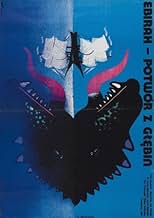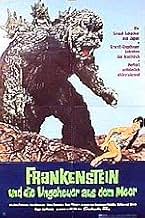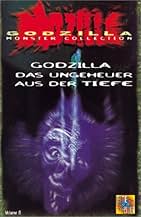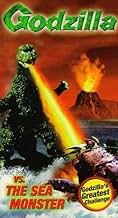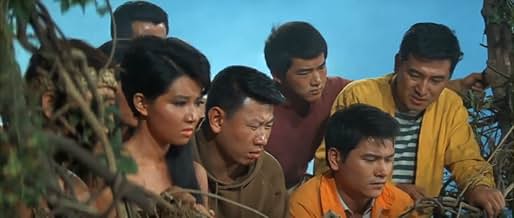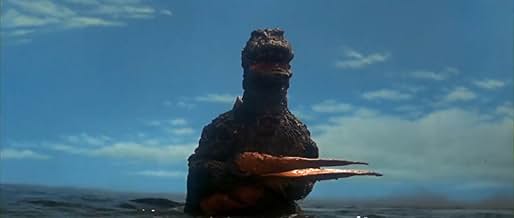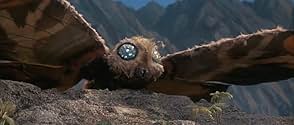Ebirah, o Terror dos Abismos
Título original: Gojira · Ebira · Mosura Nankai no daikettô
AVALIAÇÃO DA IMDb
5,5/10
6,9 mil
SUA AVALIAÇÃO
Adicionar um enredo no seu idiomaFour men searching for one's brother are shipwrecked on Letchi Island, where they encounter Godzilla, a monstrous lobster, and terrorists who have enslaved the natives of Infant Island.Four men searching for one's brother are shipwrecked on Letchi Island, where they encounter Godzilla, a monstrous lobster, and terrorists who have enslaved the natives of Infant Island.Four men searching for one's brother are shipwrecked on Letchi Island, where they encounter Godzilla, a monstrous lobster, and terrorists who have enslaved the natives of Infant Island.
Avaliações em destaque
Almost all Kaiju flicks involve two story lines, the story of the little guys and the story of the monsters. This is one of them where the story of the little guys is what really matters. A distinctly B movie, half-espionage and half-island-action, about a guy's search for his brother and getting caught up with a gang of various other guys and a beautiful native to stave off an organization's evil deeds in the South pacific. Pretty scenery. Pretty natives. Some fair jokes and some good 1960's style cheese action. Even Ebirah, a jumbo jumbo shrimp who guards the island, more or less, works well enough as a background piece. It is when the big piece of seafood tries to take center stage that things start slowing down.
By the time Godzilla shows up, the movie suffers from the monsters. Not only does the original Japanese soundtrack have a habit of playing just about the most inappropriate music for all of his scenes (look, jets are coming, let's play surf rock...he's smashing a base, let's play slow horror mood music); but there is the distinct problem the director has in getting the transition from Godzilla as a monster to a potential hero down right. Too often, Godzilla's actions make no sense. He seems to like people in one scene. In the next, he is randomly destroying things again.
The movies final problem is the Kaiju fights sort of repeat themselves. Whether it be the two monsters throwing rocks back and forth more than once, or the exact same "flip" later on, it does seem a little out of place.
By the time Godzilla shows up, the movie suffers from the monsters. Not only does the original Japanese soundtrack have a habit of playing just about the most inappropriate music for all of his scenes (look, jets are coming, let's play surf rock...he's smashing a base, let's play slow horror mood music); but there is the distinct problem the director has in getting the transition from Godzilla as a monster to a potential hero down right. Too often, Godzilla's actions make no sense. He seems to like people in one scene. In the next, he is randomly destroying things again.
The movies final problem is the Kaiju fights sort of repeat themselves. Whether it be the two monsters throwing rocks back and forth more than once, or the exact same "flip" later on, it does seem a little out of place.
This was obviously made because Toho wanted to discover new plot elements for their kaiju film formula, which was falling into something of a predictable rut (humans fight humans, humans fight monster, monster fights monster, sayonara). But simply limiting the amount of time the monsters appear on screen offers no improvement.
"Sea Monster" is one of the weaker entries in the original Godzilla series. Much of the film is directed as light comedy, a mild satire on the James Bond films. Actually, the comedy works pretty well; it's never knee-slapping laugh-out-loud, but it finds and sustains a level of humor most viewers should find fairly easy to live with.
The monsters here are almost tossed in for deus-ex-machina plot devices, saving the day at the last moment. To be sure, it's amusing to see Godzilla sit around pondering what to do with the woman he's just saved from bad guys, but there really isn't much for him to do here. He zaps a giant vulture, pulls the claws off a lobster and smashes a nuclear power plant - and that's about it. For a minute towards the end, it almost looks like things will get complicated by a battle between Godzilla and Mothra, but this doesn't really amount to much either.
For Godzilla completists, it's a relatively harmless sub-par entry - it certainly doesn't scrape the same bottoms as "Godzilla's Revenge" or "vs. Megalon". But if you are not yet a Big G. fan, this should not be your introduction to the series.
Entertaining fluff, nothing more.
"Sea Monster" is one of the weaker entries in the original Godzilla series. Much of the film is directed as light comedy, a mild satire on the James Bond films. Actually, the comedy works pretty well; it's never knee-slapping laugh-out-loud, but it finds and sustains a level of humor most viewers should find fairly easy to live with.
The monsters here are almost tossed in for deus-ex-machina plot devices, saving the day at the last moment. To be sure, it's amusing to see Godzilla sit around pondering what to do with the woman he's just saved from bad guys, but there really isn't much for him to do here. He zaps a giant vulture, pulls the claws off a lobster and smashes a nuclear power plant - and that's about it. For a minute towards the end, it almost looks like things will get complicated by a battle between Godzilla and Mothra, but this doesn't really amount to much either.
For Godzilla completists, it's a relatively harmless sub-par entry - it certainly doesn't scrape the same bottoms as "Godzilla's Revenge" or "vs. Megalon". But if you are not yet a Big G. fan, this should not be your introduction to the series.
Entertaining fluff, nothing more.
Of all the Japanese monster films that came out from the mid Fifties to the mid Seventies, Godzilla Versus The Sea Monster is the only one that seems to have taken a political stand on anything. The Japanese for obvious reasons are big on nuclear disarmament. This film involves Godzilla and two other giant monsters involved with the Red Bamboo who are a group conducting nuclear experiments on a deserted south sea island. Of course there was no such a group as the Red Bamboo, but the power across the Sea of Japan did have a Red Guard who were pretty active in those days. I think that was another political statement that Godzilla Versus The Sea Monster was making.
Anyway some 20 somethings who were involved in a dance marathon which opened the film, commandeer a boat that was to be the getaway vehicle of a bank robber to search for the brother of one of them who set sail southeast and was not heard from.
It's there that a storm washes them ashore on the island of the Red Bamboo. These dastardly folks are not only conducting nuclear experiments, they're making heavy water to use as nuclear fuel, but are using slave labor. The slaves are being taken from the island that Mothra resides, but he's sleeping and the natives are doing their best to arouse their friend and protector.
To discourage escape in the meantime, the island is guarded by Ebirah a giant lobster monster. The Red Bamboo controls him by means of the nectar of some exotic tropical fruit that acts as a tranquilizer.
When our heroes arrive, they discover that Godzilla is in some kind of coma asleep on the island. Needing an ally they look to get him awake to start doing his thing. Of course all three monsters battle it out in the end.
This particular all star monster spectacular is a cut above the others for its political statement wrapped up in the dopey way these films play. But I have to admit a soft spot in my heart for them.
Anyway some 20 somethings who were involved in a dance marathon which opened the film, commandeer a boat that was to be the getaway vehicle of a bank robber to search for the brother of one of them who set sail southeast and was not heard from.
It's there that a storm washes them ashore on the island of the Red Bamboo. These dastardly folks are not only conducting nuclear experiments, they're making heavy water to use as nuclear fuel, but are using slave labor. The slaves are being taken from the island that Mothra resides, but he's sleeping and the natives are doing their best to arouse their friend and protector.
To discourage escape in the meantime, the island is guarded by Ebirah a giant lobster monster. The Red Bamboo controls him by means of the nectar of some exotic tropical fruit that acts as a tranquilizer.
When our heroes arrive, they discover that Godzilla is in some kind of coma asleep on the island. Needing an ally they look to get him awake to start doing his thing. Of course all three monsters battle it out in the end.
This particular all star monster spectacular is a cut above the others for its political statement wrapped up in the dopey way these films play. But I have to admit a soft spot in my heart for them.
This is one of the first Godzilla movies I saw, and when I see it now after seeing almost all of the other movies, it still holds up pretty well. The main problem is, of course, Ebirah. Definetly Godzilla's worst foe. I mean, really, A GIANT LOBSTER!? But, other than that, the film is quite good, following the usual trend that the Godzilla movies tend to have much better plots than their american counterparts of the time. Here we have a young man trying to find his brother taking his friends with him to look at boats. When they board one to look around, they find a man with a gun to greet them. He claims to be the owner and allows them to spend the night on the boat. When they wake up the next morning, however, the young man has taken the boat to find his brother. It's wrecked in a storm and they are stranded on an island where they discover a secret organisation called the Red Bamboo is using slave labor to make nuclear weapons. Ebirah, a giant lobster, prevents boats from entering or leaving the island, and Okondoru, a giant condor, prevents planes from arriving. The man who claimed to own the boat, Yoshimura, turns out to be both a thief and the most resourceful member of their little group (which now also includes an escaped slave played by the wonderful Kumi Mizuno). They discover that Godzilla is sleeping on the island, so they wake him up in order to stop the Red Bamboo. He trashes the base, defeats the two other, ahem, monsters, and the slaves and group are all saved by Mothra (who really isn't looking to good by now). The thief, Yoshimura, is definetly my favorite character in this, and the special effects are pretty good at times (he may be a pathetic monster, but Ebirah looks great). As a bonus, it also makes for a great MST3K episode.
Yes. I'll admit it . This is a bad movie. A bad movie that I've watched over and over and over and over again! It is weird how much I like this movie. You could say I like it ironically, but not really, because I believe it has a type of charm that I find intentional. The monster fights are fun, and I like the plot. I totally understand people that hate this entry in the series, but I find it to be one of the most fun Godzilla movies out there!
On my Top 10 Godzilla Films list, it is actually included. Here's the list: 1.Gojira 2.Godzilla vs. Mechagodzilla 3.Godzilla vs. King Ghidorah 4.Godzilla: Final Wars 5.Mothra vs. Godzilla 6.Godzilla vs. Destroyah 7.Godzilla vs. Spacegodzilla 8.Godzilla, Mothra, and King Ghidorah: Giant Monsters All Out Attack 9.Ghidorah: The Three-Headed Monster 10.(this film.)
On my Top 10 Godzilla Films list, it is actually included. Here's the list: 1.Gojira 2.Godzilla vs. Mechagodzilla 3.Godzilla vs. King Ghidorah 4.Godzilla: Final Wars 5.Mothra vs. Godzilla 6.Godzilla vs. Destroyah 7.Godzilla vs. Spacegodzilla 8.Godzilla, Mothra, and King Ghidorah: Giant Monsters All Out Attack 9.Ghidorah: The Three-Headed Monster 10.(this film.)
Você sabia?
- CuriosidadesThis film was originally written to star King Kong, as Rankin/Bass Productions had provided Toho with the license to the character in order to produce a tie-in film for Toei's animated TV series King Kong (1966), which they co-produced. However, Rankin/Bass rejected the original treatment, as they wanted director Ishirô Honda to helm the film. Toho insisted on Jun Fukuda and after Rankin/Bass backed out, Toho decided to replace King Kong with Godzilla. Toho and Rankin/Bass would then go on to co-produce A Fuga de King-Kong (1967), a film that was more in line with what Rankin/Bass wanted.
- Erros de gravaçãoAt the end of the film, as Mothra flies back to Infant Island, the large net she is carrying with her feet with the humans inside it is missing.
- Cenas durante ou pós-créditosFor the Columbia/Tri-Star U.S. DVD release of the film, which uses the original uncut Japanese version of it, its English-language credits list the noted composer Masaru Satô as "Mararu Sato."
- Versões alternativasThe Mystery Science Theater 3000 version of the film featured a Film Ventures-lensed print of it that used a different title sequence made up of clips from the next film in the Godzilla series, O Filho de Godzilla (1967).
- ConexõesEdited into Monstrolândia (1969)
Principais escolhas
Faça login para avaliar e ver a lista de recomendações personalizadas
- How long is Ebirah, Horror of the Deep?Fornecido pela Alexa
Detalhes
- Data de lançamento
- País de origem
- Idioma
- Também conhecido como
- Ebirah, Horror of the Deep
- Empresa de produção
- Consulte mais créditos da empresa na IMDbPro
Bilheteria
- Orçamento
- US$ 1.200.000 (estimativa)
- Tempo de duração1 hora 27 minutos
- Mixagem de som
- Proporção
- 2.35 : 1
Contribua para esta página
Sugerir uma alteração ou adicionar conteúdo ausente

Principal brecha
By what name was Ebirah, o Terror dos Abismos (1966) officially released in India in English?
Responda

